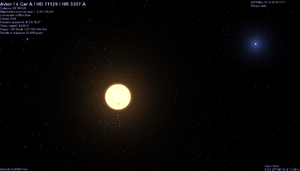Avior
Avior (also known as Epsilon Carinae)[1] is a binary star system located in the southern constellation of Carina. It has an apparent magnitude of +1.86 making it the 41st brightest star in the night sky, but it is not visible from most of the northern hemisphere. The False Cross is an asterism formed of Delta Velorum, Kappa Velorum, Aspidiske (Iota Carinae) and Avior (Epsilon Carinae). It is called the False Cross because it is sometimes mistaken for the Southern Cross, causing problems in astronavigation.[2]
Avior is located about 560–660 light years from the Sun.[3] Measurements during the Hipparcos mission give the pair an angular separation of 0.46 arcseconds with a difference in magnitude of 2.0.[4] At their estimated distance, this angle is equal to a physical separation of around 4 astronomical units[5]
The main star has an apparent magnitude of 2.01,[6] which by itself would still make it the third-brightest star in the constellation. It is an evolved giant star with a stellar classification of K3 III. However, examination of the ultraviolet light emitted from this star suggests it may instead be of spectral type K7.[7] The fainter secondary star has an apparent magnitude of 3.85,[8] which, if it were a single star, would be bright enough to be seen with the naked eye. This is a hot, core hydrogen-fusing B-type main sequence star of spectral class B2 Vp.[9] The secondary star may itself have an orbiting stellar companion of spectral class F8.[10] This pair may form an eclipsing binary system[11] with a period of 785 days (2.15 years), resulting in a magnitude change of 0.12 during each eclipse.[12][13]
References
- ↑ "IAU Catalog of Star Names". Retrieved 28 July 2016.
- ↑ Moore, Patrick (2010). Patrick Moore's Astronomy: Teach Yourself. Hachette. ISBN 978-1444129779.
- ↑ van Leeuwen, F. (November 2007), "Validation of the new Hipparcos reduction", Astronomy and Astrophysics, 474 (2): 653–664, arXiv:0708.1752, Bibcode:2007A&A...474..653V, doi:10.1051/0004-6361:20078357, S2CID 18759600.
- ↑ Parsons, Sidney B.; Ake, Thomas B. (November 1998), "Ultraviolet and Optical Studies of Binaries with Luminous Cool Primaries and Hot Companions. V. The Entire IUE Sample", The Astrophysical Journal Supplement Series, 119 (1): 83–104, Bibcode:1998ApJS..119...83P, doi:10.1086/313152.
- ↑ Kaler, James B., "AVIOR (Epsilon Carinae)", Stars, University of Illinois, retrieved 2012-02-12.
- ↑ Template:Cite simbad
- ↑ Parsons, Sidney B.; Ake, Thomas B. (November 1998), "Ultraviolet and Optical Studies of Binaries with Luminous Cool Primaries and Hot Companions. V. The Entire IUE Sample", The Astrophysical Journal Supplement Series, 119 (1): 83–104, Bibcode:1998ApJS..119...83P, doi:10.1086/313152.
- ↑ Template:Cite simbad
- ↑ Parsons, Sidney B.; Ake, Thomas B. (November 1998), "Ultraviolet and Optical Studies of Binaries with Luminous Cool Primaries and Hot Companions. V. The Entire IUE Sample", The Astrophysical Journal Supplement Series, 119 (1): 83–104, Bibcode:1998ApJS..119...83P, doi:10.1086/313152.
- ↑ Cite error: Invalid
<ref>tag; no text was provided for refs namedaj127_5_2915. - ↑ Kaler, James B., "AVIOR (Epsilon Carinae)", Stars, University of Illinois, retrieved 2012-02-12.
- ↑ Hoffleit, Dorrit; Warren Jr, W. H., The Bright Star Catalogue (5th revised ed.), Smithsonian Astrophysical Observatory, retrieved 2012-02-12.. See: VizieR V/50
- ↑ Hoffleit, Dorrit (1996), "A Catalogue of Correlations Between Eclipsing Binaries and Other Categories of Double Stars", The Journal of the American Association of Variable Star Observers, 24 (2): 105–116, Bibcode:1996JAVSO..24..105H
